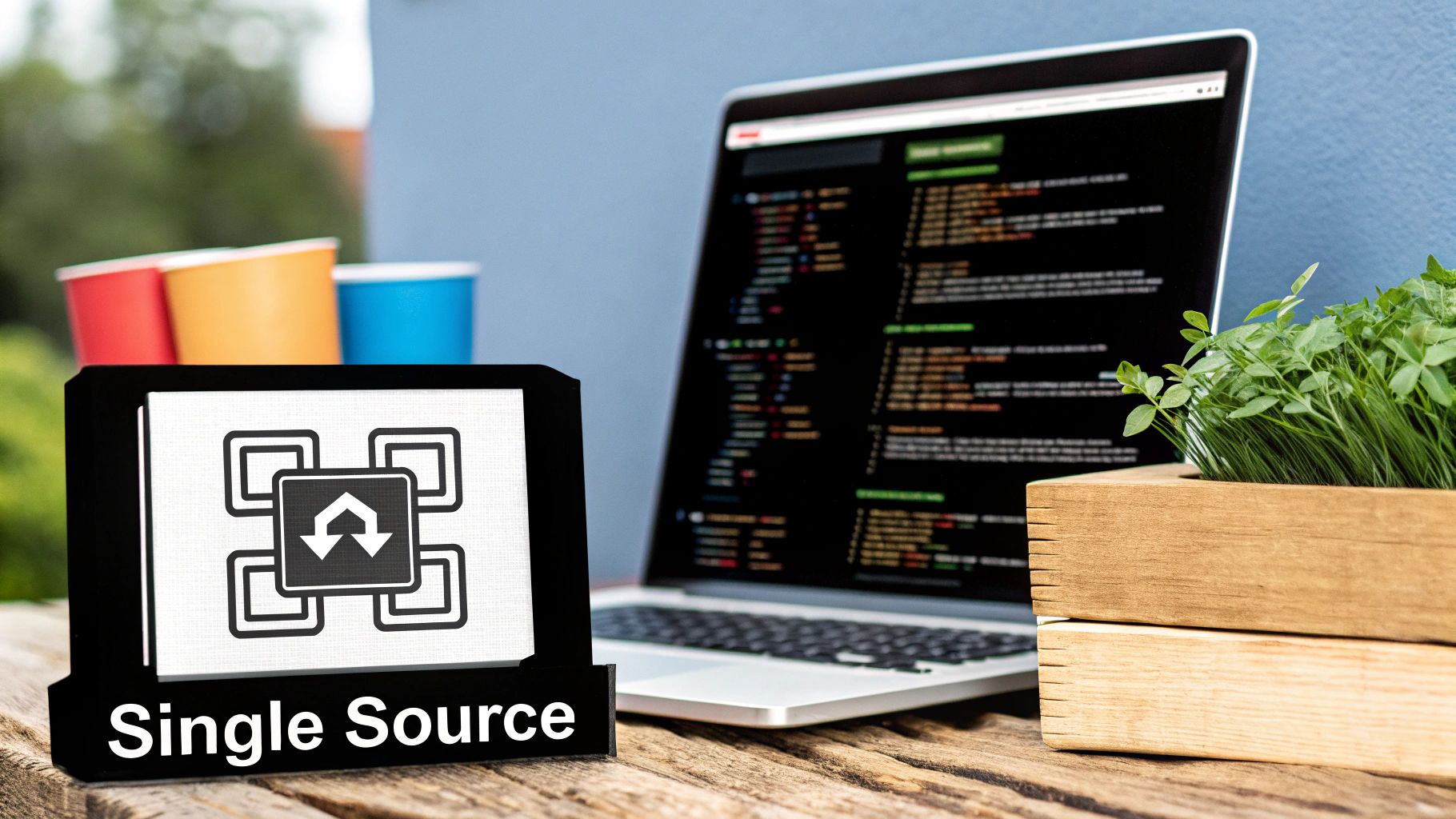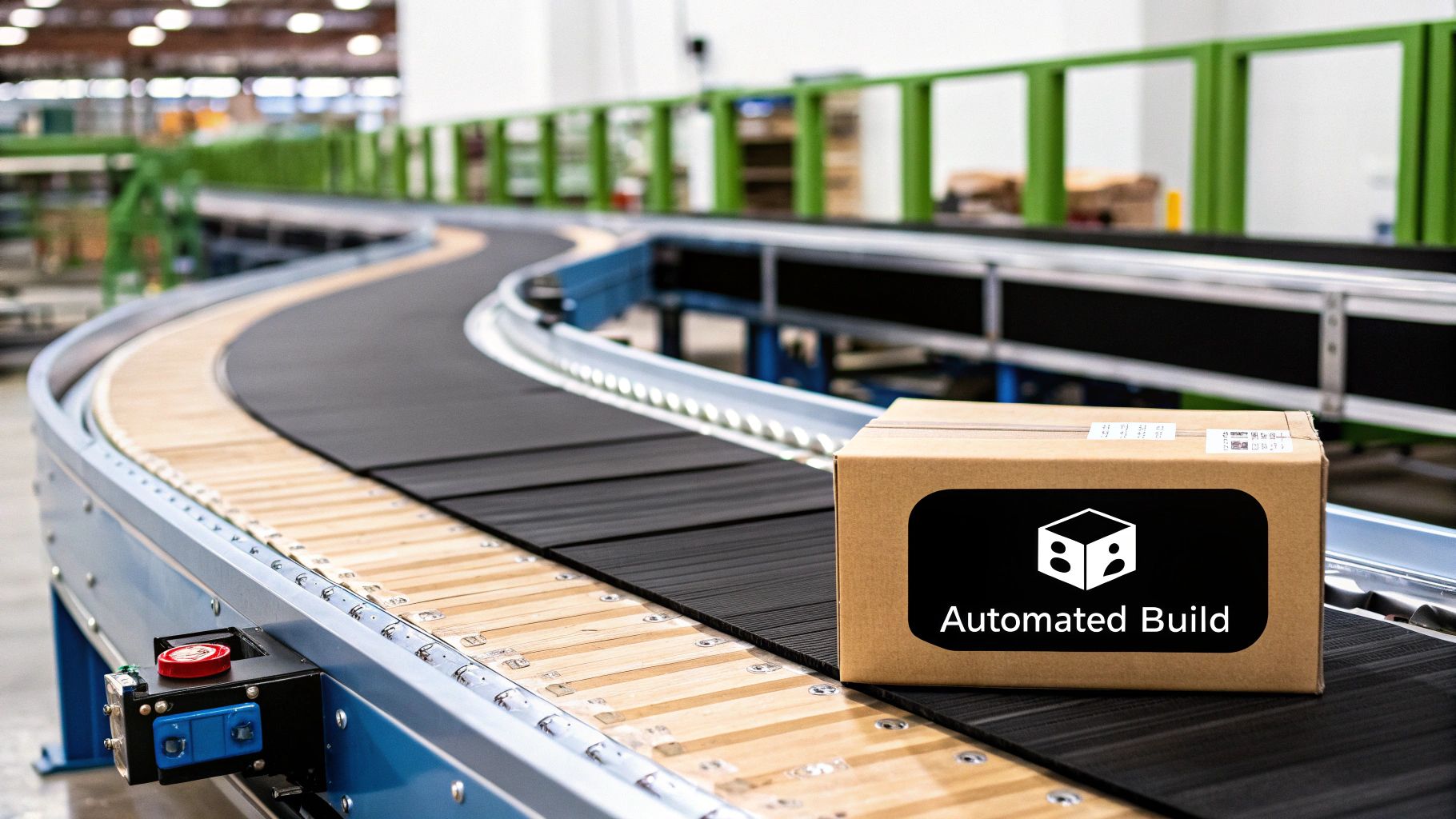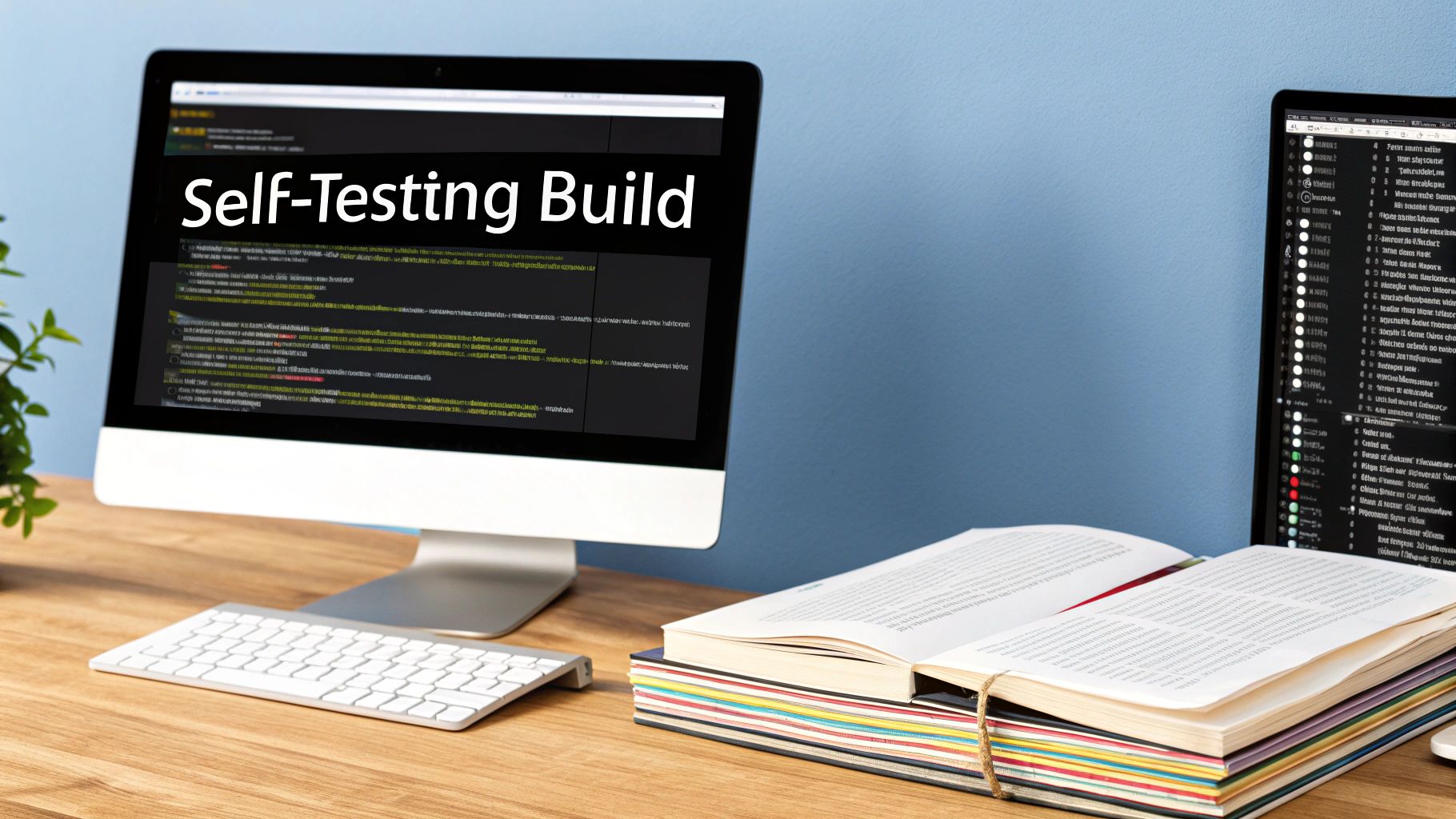Top Continuous Integration Best Practices for Faster Releases
In a fast-paced development landscape, continuous integration is the engine driving rapid innovation and reliable software delivery. A well-oiled CI pipeline prevents integration nightmares, catches bugs early, and empowers teams to ship code with confidence. But are you truly leveraging its full potential? Sticking to outdated or surface-level practices can turn your CI process into a bottleneck rather than a competitive advantage. This guide cuts through the noise, detailing seven essential continuous integration best practices that modern engineering teams use to build, test, and deploy software more effectively than ever before.
We'll move beyond the basics, offering actionable insights and real-world examples to help you transform your pipeline into a strategic asset. You will learn how to implement everything from disciplined version control and automated self-testing builds to creating fast feedback loops and robust monitoring. As you work towards modernizing your CI pipeline and transforming it from a bottleneck to a backbone, exploring broader process improvement strategies can provide valuable insights for streamlining development workflows.
Each practice outlined below is designed to be immediately applicable, whether you are a developer, QA engineer, or technical lead. By adopting these methods, your team can achieve faster, more reliable, and more consistent software delivery cycles.
1. Commit Early, Commit Often
The foundational principle of any successful continuous integration (CI) pipeline is the practice of committing small, incremental changes to a shared repository frequently. Rather than bundling weeks of work into a single, massive commit, developers break down features and fixes into logical, atomic units. Each unit is integrated into the main branch multiple times a day, forming the bedrock of a robust and healthy CI culture.
This approach is one of the most critical continuous integration best practices because it fundamentally minimizes risk. Small, frequent commits are easier for team members to review, simpler to understand, and can be reverted with minimal disruption if an issue arises. This dramatically reduces the likelihood of complex, time-consuming merge conflicts and ensures the main development branch remains stable and consistently deployable.

Why It Works
Frequent integration provides a rapid feedback loop. Each time a developer pushes a small change, the automated CI server builds and tests the entire application. This means bugs are caught within minutes of being introduced, not weeks later during a stressful pre-release phase. Companies like Google, with its massive monorepo, and Facebook, known for its rapid release cycles, have institutionalized this practice to manage complexity and maintain velocity at an immense scale.
Actionable Implementation Tips
To adopt this practice effectively, teams should focus on discipline and automation.
- Use Feature Flags: Integrate code into the main branch even if the feature is incomplete. Wrap the new functionality with a feature flag (or feature toggle) to keep it hidden from users in production until it's ready for release.
- Implement Pre-Commit Hooks: Automate quality checks before a commit is even created. Use tools like Husky or pre-commit to run linters, formatters, and lightweight tests on a developer's local machine, ensuring code adheres to project standards.
- Standardize Commit Messages: Follow a convention, such as the Conventional Commits specification. Formatted messages like
feat: add user login endpointorfix: correct validation errormake the project history readable and enable automated changelog generation. - Protect Your Main Branch: Configure branch protection rules in your version control system (e.g., GitHub, GitLab). Require status checks to pass and a minimum number of reviews before code can be merged, safeguarding the stability of your primary branch.
2. Maintain a Single Source Repository
A core tenet of effective continuous integration is the principle of a single, authoritative source of truth. This practice involves storing all assets required to build, test, and deploy an application in a centralized version control repository. This includes not just the application source code but also build scripts, infrastructure as code (IaC) definitions, database migration scripts, and configuration files. Having everything in one place ensures that any developer can check out a copy of the repository and reliably reproduce the entire system.
This centralized approach, often called a "single source repository," is one of the most vital continuous integration best practices because it eliminates ambiguity and streamlines automation. When the CI server triggers a build, it pulls from one definitive location, guaranteeing that it uses the correct versions of all components. This prevents the classic "it works on my machine" problem and ensures that builds are consistent, repeatable, and traceable, which is fundamental for auditing and debugging.

Why It Works
A single repository simplifies the entire development lifecycle. Onboarding new team members becomes trivial: they just need to clone the repository. Reverting to a previous stable state is straightforward because every change is versioned together. This practice has been proven at incredible scales, from the development of the Linux kernel, where thousands of contributors collaborate through Git, to Microsoft's massive migration of the Windows codebase to a single Git repository to unify its development efforts.
Actionable Implementation Tips
To successfully implement a single source repository, teams should establish clear rules and use the right tools.
- Use
.gitignoreFiles: Proactively maintain a comprehensive.gitignorefile to exclude build artifacts, local environment files (.env), and dependency folders (node_modules). This keeps the repository clean and focused only on source-controlled assets. - Implement a Clear Branching Strategy: Adopt a standardized branching model like GitFlow or the simpler GitHub Flow. A consistent strategy provides a clear structure for managing features, releases, and hotfixes, preventing chaos in the main branch.
- Store Configurations as Templates: Never commit sensitive information like API keys or passwords directly. Instead, commit template configuration files (e.g.,
config.template.yaml) with placeholder values. The CI/CD pipeline or a secrets management tool can then inject the actual secrets during deployment. - Leverage Git LFS for Large Files: For projects that include large binary assets like graphics, videos, or compiled libraries, use Git Large File Storage (LFS). This keeps the core repository size small and performant by storing pointers to large files instead of the files themselves.
3. Automate the Build Process
At the heart of continuous integration is the complete automation of the build process. This practice ensures that source code from version control is reliably and repeatably transformed into a deployable artifact without any manual intervention. An automated build script handles everything: compiling code, running tests, packaging the application, and even preparing it for deployment. It serves as the single source of truth for creating the software, making the process transparent and consistent for every developer and every commit.
This is one of the most essential continuous integration best practices because it eliminates "it works on my machine" problems and removes human error from the equation. A fully automated, one-step build guarantees that if the process succeeds, the resulting artifact is valid and ready for the next stage, whether that's further testing or deployment.

Why It Works
An automated build provides immediate, objective feedback on the health of the codebase. Every time code is pushed, the CI server executes the build script, validating the integration of the new changes. This self-testing build acts as a gatekeeper, preventing broken code from progressing down the pipeline. Companies like Spotify rely on sophisticated automated build systems to manage their complex microservices architecture, allowing hundreds of teams to build and deploy their services independently and safely. Similarly, Etsy’s famous deployment pipeline is built on a foundation of fast, automated builds that enable them to deploy dozens of times a day.
Actionable Implementation Tips
To successfully automate your build, focus on scripting, speed, and environmental consistency.
- Use Standard Build Tools: Adopt mature build tools appropriate for your tech stack, such as Maven or Gradle for Java, MSBuild for .NET, or npm/Yarn scripts for JavaScript. These tools provide a standardized way to define build steps and manage dependencies.
- Keep Build Times Short: Aim to keep your primary build and test cycle under 10 minutes. Slow builds discourage frequent commits. Use techniques like caching dependencies, running tests in parallel, and splitting large test suites to accelerate the feedback loop.
- Containerize the Build Environment: Use Docker to define and containerize your build environment. This ensures the build runs with the exact same dependencies, tools, and configurations on a developer's local machine as it does on the CI server, eliminating environment-specific failures.
- Make the Build Script Version-Controlled: The script that builds your software is a critical piece of your project. Store it in the same version control repository as your source code (e.g., a
Jenkinsfile,.gitlab-ci.yml, orMakefile). This ensures that changes to the build process are tracked and can be reviewed just like any other code.
4. Make Builds Self-Testing
A core tenet of continuous integration is that a build should be its own quality gate. The practice of making builds self-testing means that every commit triggers an automated process that not only compiles the code but also executes a comprehensive suite of tests. If any test fails, the build is immediately marked as broken, preventing defective code from ever reaching the main branch or progressing to later stages.
This approach transforms the CI pipeline from a simple code compiler into a vigilant, automated quality assurance system. It is one of the most vital continuous integration best practices because it provides immediate, unambiguous feedback on the health of the application. A successful build is a strong signal of confidence, while a failed build pinpoints the exact change that introduced a regression, enabling rapid diagnosis and repair.

Why It Works
A self-testing build institutionalizes quality by making it a non-negotiable part of the integration process. This practice, heavily influenced by pioneers like Kent Beck, ensures that quality is built in, not bolted on later. Tech giants like Google and Amazon rely on massive, sophisticated automated testing infrastructures to manage the complexity of their services. Every change to AWS, for instance, undergoes rigorous automated testing to prevent service disruptions for millions of users.
Actionable Implementation Tips
To create a truly self-testing build system, focus on speed, reliability, and coverage.
- Follow the Test Pyramid: Balance your test suite with a large base of fast unit tests, a smaller layer of integration tests, and a minimal number of end-to-end UI tests. This optimizes for both feedback speed and confidence.
- Parallelize Test Execution: Configure your CI server to run tests in parallel across multiple agents or containers. This drastically reduces the total build time, keeping the feedback loop tight even as the test suite grows.
- Quarantine Flaky Tests: Unreliable tests that fail intermittently undermine trust in the build process. Isolate these "flaky" tests immediately and fix them as a high-priority task to maintain the integrity of your CI feedback.
- Monitor Test Coverage: Use tools like JaCoCo or Istanbul to track code coverage metrics, but focus on the quality and relevance of tests, not just the raw percentage. As you add more complex checks, you can learn more about automated functional testing and how to improve your strategies.
5. Fast Build Feedback
A core tenet of effective continuous integration is a rapid feedback loop. If a build and its associated tests take an hour to run, the "continuous" aspect of CI loses its power. The practice of maintaining fast build feedback, ideally keeping the entire cycle under 10 minutes, ensures that developers receive information about their changes almost immediately, allowing them to iterate quickly and maintain momentum.
This practice is one of the most vital continuous integration best practices because it directly impacts developer productivity and focus. When a build is quick, developers can wait for the result without context switching to another task. This speed encourages frequent commits and integrations, as the process is painless and provides immediate validation, reinforcing the positive habits that prevent integration hell.
Why It Works
A sub-10-minute build cycle ensures that integration issues are discovered and fixed while the original changes are still fresh in a developer's mind. It prevents a backlog of failed builds and keeps the main branch in a healthy, deployable state. Tech giants have invested heavily in this principle; for example, Dropbox famously optimized its build system to reduce times from over 45 minutes to just 5, and Uber implemented a distributed build system to manage the complexity of its mobile apps without sacrificing speed.
Actionable Implementation Tips
To achieve and maintain fast feedback, teams must actively monitor and optimize their build pipelines.
- Implement Build Pipeline Stages: Structure your build to run the fastest, most critical tests first. A typical pipeline might start with linting and unit tests, which provide feedback in seconds, followed by more time-consuming integration or end-to-end tests. This "fail-fast" approach ensures developers are notified of simple errors immediately.
- Optimize Test Execution: Parallelize your test suite to run multiple tests simultaneously across different machines or containers. This can drastically cut down execution time. Learn more about how to get started with testing in parallel on dotmock.com.
- Use Build Caching and Incremental Builds: Configure your build tools to cache dependencies and unchanged artifacts. Tools like Gradle, Bazel, or Nx use sophisticated caching to rebuild only the parts of the codebase that have actually changed, avoiding redundant work.
- Profile Your Build: Regularly use profiling tools to identify bottlenecks in your build and test process. Pinpoint specific tests or build steps that consume the most time and focus optimization efforts there.
6. Test in Production-Like Environment
One of the most common causes of deployment failure is the drift between development, testing, and production environments. Testing in a production-like environment is a continuous integration best practice that directly addresses this by creating staging or pre-production environments that precisely mirror the live system. This includes matching infrastructure, network configurations, third-party service dependencies, and data structures.
This practice ensures that what works in the CI pipeline will also work for the end-user. By closing the gap between test and reality, teams can uncover environment-specific bugs, performance bottlenecks, and configuration errors that simpler unit or integration tests would miss. This reduces deployment risk and increases confidence that the application will behave as expected once it goes live.
Why It Works
Running automated builds and tests in a mirrored environment catches issues that only manifest under real-world conditions. It validates not just the application code but also the entire deployment process and infrastructure configuration. Companies like Airbnb and Shopify invest heavily in maintaining high-fidelity staging environments, allowing their teams to deploy new features multiple times a day with a high degree of confidence, knowing that the code has already proven itself in an identical setting.
Actionable Implementation Tips
Building and maintaining a true production-like environment requires a strategic approach focused on automation and consistency.
- Use Infrastructure as Code (IaC): Employ tools like Terraform or AWS CloudFormation to define and manage your infrastructure programmatically. This ensures your staging and production environments are built from the same templates, eliminating manual configuration errors and preventing drift.
- Containerize Applications: Package your application and its dependencies into containers using Docker or a similar technology. Containers ensure that the application runs identically regardless of the underlying environment, from a developer's laptop to the production server.
- Leverage Data Masking: Use realistic, but anonymized, data in your testing environment. Replicating production data volumes and structures is crucial for performance testing and catching data-related bugs without exposing sensitive user information.
- Implement Blue-Green Deployments: This strategy involves maintaining two identical production environments ("blue" and "green"). You can deploy and conduct final end-to-end testing on the inactive environment before routing live traffic to it, providing a seamless and low-risk release process.
7. Implement Comprehensive Build Monitoring and Notifications
A CI pipeline is only as good as its visibility. Simply running builds is not enough; teams need a robust system to monitor build status, track performance, and receive immediate notifications when something goes wrong. This practice involves setting up comprehensive logging, dashboards, and alerting mechanisms to ensure that build failures are treated as high-priority, all-hands-on-deck events.
This is a cornerstone of continuous integration best practices because it transforms the CI server from a silent background process into an active, communicative member of the team. When a build breaks, the right people should know about it instantly, with enough context to diagnose the problem quickly. This prevents broken builds from languishing for hours, blocking other developers and grinding productivity to a halt.
Why It Works
Immediate, actionable feedback is the goal. When a build fails, a well-configured notification system instantly alerts the responsible team or developer via channels like Slack or Microsoft Teams. This immediate awareness creates a culture of accountability where fixing the build becomes the top priority. Companies like Atlassian and GitHub have built entire products around this principle, integrating build status directly into their collaboration tools and providing centralized dashboards for a clear, real-time overview of pipeline health.
Actionable Implementation Tips
To create a transparent and responsive build environment, focus on clarity and immediacy.
- Integrate with ChatOps: Connect your CI server to your team's chat application (e.g., Slack, MS Teams). Configure notifications to post build successes, failures, and even deployment statuses to a dedicated channel. This makes build status a visible part of the team's daily conversation.
- Set Up Build Radiators: Display a dedicated build dashboard on a large screen in a common team area. A build radiator provides a highly visible, at-a-glance status of the main branch, often turning red to signal a failure and green for success, ensuring everyone is aware of the current state.
- Track Key CI Metrics: Monitor and log metrics beyond simple pass/fail. Track build duration, test flakiness, build frequency, and mean time to recovery (MTTR) for failures. These data points help identify bottlenecks and areas for pipeline improvement.
- Implement Smart Notifications: Avoid alert fatigue by configuring intelligent notifications. Instead of notifying the entire team for every failure, direct alerts to the developer who committed the breaking change. Set up escalation rules that notify a wider group if the failure is not addressed within a specific timeframe.
7 Best Practices Comparison Matrix
| Practice | Implementation Complexity 🔄 | Resource Requirements ⚡ | Expected Outcomes 📊 | Ideal Use Cases 💡 | Key Advantages ⭐ |
|---|---|---|---|---|---|
| Commit Early, Commit Often | Medium 🔄 | Low ⚡ | Faster feedback, fewer merge conflicts 📊 | Agile teams, continuous integration 💡 | Easier bug identification, better collaboration ⭐ |
| Maintain a Single Source Repository | Medium 🔄 | Medium ⚡ | Centralized control, consistent environment 📊 | Projects needing unified version control 💡 | Single source of truth, audit trail, onboarding ⭐ |
| Automate the Build Process | High 🔄 | Medium-High ⚡ | Reliable, repeatable builds 📊 | Projects requiring frequent builds 💡 | Reduces human error, consistent artifacts ⭐ |
| Make Builds Self-Testing | High 🔄 | Medium-High ⚡ | Early bug detection, higher code confidence 📊 | Quality-focused projects, TDD environments 💡 | Prevents broken code, immediate feedback ⭐ |
| Fast Build Feedback | High 🔄 | High ⚡ | Faster iteration, higher productivity 📊 | Large or complex projects needing quick builds 💡 | Reduces context switching, promotes CI adoption ⭐ |
| Test in Production-Like Environment | High 🔄 | High ⚡ | Fewer deployment issues, realistic testing 📊 | Systems sensitive to environment differences 💡 | Early detection of environment issues ⭐ |
| Comprehensive Build Monitoring & Notifications | Medium 🔄 | Medium ⚡ | Quick issue resolution, improved team awareness 📊 | Teams requiring strong build visibility 💡 | Immediate alerts, data-driven improvements ⭐ |
Elevating Your Development Workflow with Superior CI
Transitioning from traditional development cycles to a robust continuous integration (CI) pipeline is more than just a technical upgrade; it's a fundamental shift in team culture and mindset. The journey to mastering CI is paved with the principles we've explored, each one a critical pillar supporting a faster, more reliable, and collaborative software development lifecycle. By embracing these continuous integration best practices, you are not merely automating tasks but actively building a resilient foundation for innovation and quality.
From Theory to Tangible Results
The core philosophy is simple yet powerful: make small, incremental changes, integrate them frequently, and validate them automatically. This approach, built upon a single source repository and frequent commits, systematically dismantles the risks associated with large, monolithic updates. It transforms the dreaded "merge hell" into a manageable, predictable process. When you layer in automated builds and self-testing mechanisms, you create a powerful, self-regulating system that catches issues moments after they are introduced, not weeks later during a stressful pre-release QA phase.
The true value emerges when you connect these practices into a cohesive workflow.
- Speed is paramount. A fast build process, delivering feedback in minutes, keeps developers engaged and productive. It prevents context switching and encourages immediate fixes, compounding efficiency over time.
- Realism is non-negotiable. Testing your application against an idealized, "happy-path" environment is insufficient. Creating a clone of your production environment for your CI pipeline is essential for uncovering issues related to configuration drift, infrastructure dependencies, and third-party API behavior.
- Visibility is crucial. A silent pipeline is a mysterious one. Implementing comprehensive monitoring and clear, actionable notifications ensures that when something breaks, the right people know immediately and can act decisively.
Mastering the Unpredictable with Realistic Simulation
Perhaps the most challenging yet impactful practice is creating a truly production-like testing environment. Modern applications rarely exist in a vacuum; they depend on a complex web of internal and external APIs. These dependencies can be unreliable, slow, or return unexpected data, and your application must be built to handle such chaos gracefully.
This is where simulating failure becomes a cornerstone of advanced continuous integration best practices. Instead of hoping for the best, you can proactively test for the worst. By integrating tools that can mimic API latency, network timeouts, and various error states directly into your CI pipeline, you empower your team to build truly resilient software. This moves testing from a simple validation of features to a rigorous stress test of the application's stability and user experience under adverse conditions. Adopting these principles transforms your CI pipeline from a simple build server into an intelligent quality gate, ensuring that only the most robust, reliable code makes its way to production.
Ready to bulletproof your CI pipeline by simulating any API scenario? Start creating realistic mock APIs in seconds with dotMock. Sign up for free and see how effortless it is to test for latency, errors, and edge cases, ensuring your application is production-ready. Explore the possibilities at dotMock.